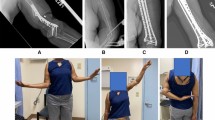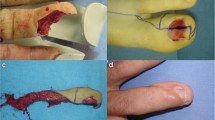Abstract
Background
The fingertip is the most commonly injured part of the hand and is an important aesthetic part of the hand.
Methods
In this retrospective study we analyzed data from 700 patients operated on between 1997 and 2008 for complications after nail splinting with native nail or silicone nail. Inclusion criteria were patients living in Bern/Berner Land, complete documentation, same surgical team, standard antibiotics, acute trauma, no nail bed transplantation, and no systemic diseases. Groups were analyzed for differences in age, gender, cause and extension of trauma, bony injury and extent, infection, infectious agent, and nail deformities. Statistical analysis was done using the χ 2 test, Fisher’s exact test, and Pearson correlation coefficients.
Results
A total of 401 patients, with a median age of 39.5 years, were included. There were more men with injured nails. Two hundred forty native nails and 161 silicone splints were used. There were 344 compression injuries, 44 amputations, and 13 avulsion injuries. Forty-three patients had an infection, with gram-positive bacteria (Staphylococcus aureus) causing most infections. A total of 157 nail dystrophies were observed, split nails most often. The native nail splint group showed significantly (p < 0.015) fewer nail deformities than the silicone nail splint group; otherwise, there were no statistical differences. However, there were twice as many infections in the silicone nail group.
Conclusion
It seems to be advantageous to use the native nail for splinting after trauma, when possible. In case of a destroyed and unusable nail plate, a nail substitute has to be used.


Similar content being viewed by others
References
Zook EG, Brown RE (2002) The perionychium. In: Neligan PC , Chang J (eds) Plastic surgery, vol 6: Hand and upper extremity. WB Saunders, Philadelphia, pp 553–623
Bharathi RR, Bajantri B (2011) Nail bed injuries and deformities of the nail. Indian J Plast Surg 44:197–202
Morgan AM, Baran R, Haneke E (2001) Anatomy of the nail unit. In: Krull EA, Zook EG, Baran R, Haneke E (eds) Nail surgery: a text and atlas. Lippincott Willimas & Wilkins, Philadelphia, pp 1–28
Eloez A, Kahraman A, Oezgenel Y (2004) Nail bed secured with a syringe splint. J Plast Reconstr Surg 114:1682–1683
Oetgen ME, Dodds SD (2008) Non-operative treatment of common finger injuries. Curr Rev Musculoskelet Med 1(2):97–102
Brown RE (2002) Acute nail bed injuries. Hand Clin 18:561–575
Mangram AJ (2001) A brief overview of the 1999 CDC Guideline for Prevention of Surgical Site Infection, Centers for Disease Control and Prevention. J Chemother 13:35–39
Cohen MS, Hennrikus WL, Botte MJ (1991) A dressing for repair of acute nail bed injury. Orthop Rev 19:882–884
Leow ME, Ng WK, Pereira BP, Kueh KA, Pho RW (1997) A technique of acrylic nail fixation in multilayered silicone finger prosthesis. Prosthet Orthot Int 21:199–201
Henderson J (2009) Shiny-side down is best for splints after nailbed repairs. J Plast Reconstr Aesthet Surg 62:479
Ogunro EO (1989) External fixation of injured nail bed with the INRO surgical nail splint. J Hand Surg 14:236–241
Bayraktar A, Ozcan M (2006) A nasogastric catheter splint for a nailbed. Ann Plast Surg 57:120
Seputiene V, Bogdaite A, Ruzauskas M, Suziedeliene E (2012) Antibiotic resistance genes and virulence factors in Enterococcus faecium and Enterococcus faecalis from diseased farm animals: pigs cattle and poultry. Pol J Vet Sci 15:431–438
Acknowledgments
This study was made possible by departmental funds.
Conflict of interest
None of the authors has any conflict of interest.
Author information
Authors and Affiliations
Corresponding author
Rights and permissions
About this article
Cite this article
Weinand, C., Demir, E., Lefering, R. et al. A Comparison of Complications in 400 Patients After Native Nail Versus Silicone Nail Splints for Fingernail Splinting After Injuries. World J Surg 38, 2574–2579 (2014). https://doi.org/10.1007/s00268-014-2583-2
Published:
Issue Date:
DOI: https://doi.org/10.1007/s00268-014-2583-2




